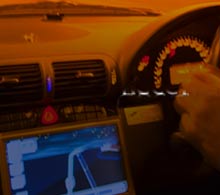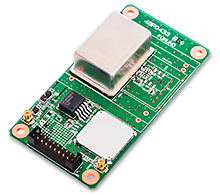Articles for ITS market Overview of the Quasi-Zenith Satellite System (QZSS) and advancements toward full-scale practical use including the Tokyo Olympic Games - G-space EXPO 2016 report -
G-space EXPO and Quasi-Zenith Satellite System (QZSS)
The G-space EXPO 2016 was held November 24 - 26, 2016 at the National Museum of Emerging Science and Innovation. G-space is a generic term for utilizing highly geospatial information. The G-space EXPO is held to highlight and publicize activities and various symposiums, mainly comprised of related companies and administrative agencies.
The background is related to the practical application of the Quasi-Zenith Satellites System (QZSS) in 2018 and promoted by the Japanese government. QZSS is one of the Japanese space strategies decided by the Cabinet in September of 2011. It is a system that complements the United States GPS (Global Positioning System). Currently "MICHIBIKI", the first QZSS satellite is in orbit for demonstration experiments and in 2017 three more aircraft will be launched. For the time being it will be operated as a four-body system. If additional funding can be secured and positive results are achieved with the 4-satellite system there is a possibility that three more satellites will be launched for a total of a seven satellite system.
Technological innovation and popularization of satellite positioning
 Model of Quasi-Zenith "Michibiki" satellite
Model of Quasi-Zenith "Michibiki" satellite
 Various equipment exhibiting transmission and reception of Quasi-Zenith satellite
Various equipment exhibiting transmission and reception of Quasi-Zenith satellite
Regarding GPS, in 1994 President Bill Clinton signed a bill to open a portion of radio waves emitted from the GPS system. The US Air Force allowed access and managed these signals to the private sector. Along with this private companies started innovating and satellite positioning technology rapidly advanced.
Included among them since the mid 1990's are companies in Japan. In-vehicle car navigation has become widespread and GPS has become commonplace. Also starting in 2000 mobile phones were equipped with GPS functions. Soon after smart phones emerged and the necessity of GPS for maps, etc. became necessary.
Although the spread of GPS has advanced, in Japan there are circumstances that limit the reception of GPS. This includes mountains where there are many forests throughout the countryside and the central part where there are many high-rise buildings. GPS needs to receive signals from at least four satellites for three-dimensional positioning and at least three satellites for two-dimensional positioning. Also in order to improve the positioning accuracy, it is desirable that those satellites are scattered in a wider area in the sky.
Due to these circumstances Japanese satellite engineers created a system where at least one satellite is located "almost directly above" Japan. This was called "Quasi-Zenith". Always having one Quasi-Zenith satellite above with three GPS satellites provides three dimensional satellite positioning. Also unlike the GPS L1 frequency which provides free access, the Quasi-Zenith satellite can also incorporate Japan specific services into various signals.
Operation of the QZSS and expectations for Japan's original service
The Quasi-Zenith Satellite is actually operated by NEC Corporation (NEC) and Mitsubishi Electric Corporation via the Quasi-Zenith Satellite System Service Co., Ltd. using the Cabinet Office's space strategy as the base.
NEC developed the comprehensive system design and verification, and operates QZSS. NEC also collaborates with Mitsubishi Electric for maintenance and maintenance of ground facilities. Apart from this flow Mitsubishi Electric maintains the satellite under the government project.
Next, I will introduce technical details of QZSS.
Four planes will be operated for the moment, three of which will span the sky from Japan to above Australia and orbit in a figure 8. Each of the three satellites will have an angle of attack of more than 20 degrees for 16 hours and stay visible in Japan for 8 hours. In other words, there are three satellites in total and at least one satellite will stay at the Quasi-Zenith in Japan every 24 hours for an 8 hour period.
The other satellite is for various backups of the three aircraft and it remains on the equator in a geostationary orbit.
The satellites on the Quasi-Zenith orbit will be 2.8 m in length x 18.9 m in width x 6.2 m in height and will be launched using the H-II 202 rocket. The satellite in the geosynchronous orbit has dimensions of length 7.1 m × width 18.9 m × height 5.4 m. The planned launch vehicle will be the H - IIA 204 rocket. Signals to be used are eight in total and they are L1C / A, L1C, L1S, L2C, L5, L5C, L6, and S band. For normal positioning information four signals including L1C / A, L1C (The center frequency is 1575.42 MHz for both), L2C (1227.60 MHz), and L5 (1176.45 MHz) are used. Receiving these multiple signals are expected to reduce the ionosphere error. In addition if the L1S signal of the sub meter class positioning augmentation information is used, the positioning accuracy (95% value) increases to 1 meter in the horizontal plane and 2 meters in the vertical plane throughout Japan. The L6 signal of precision is a centimeter class positioning reinforcement signal. Used in a stationary object environment it dramatically improves accuracy to 6 cm in the horizontal plane and 12 cm in the vertical plane. Even mobile units such as in cars have a high accuracy of 12 cm in the horizontal plane and 24 cm in the vertical plane. This is the same as RTK (Real Time Kinematic) surveying currently used for surveying etc. By communicating with electronic reference points nationwide and management station along with the GNSS receiver on the ground such surveying concepts are realized.
In addition to satellite positioning the Quasi-Zenith satellites can transmit information to on-board devices and smartphones as a crisis management report service using the L1S signal. These services include disasters like earthquakes, tsunamis and also national crisis such as terrorism, etc.
Also it is possible to send information to Quasi-Zenith satellites that unlike GPS satellites have only been used for reception. For example if you send a safety information confirmation from a smartphone etc. during distress or disaster, you can send the data received from the Quasi-Zenith satellite by the ground control station via e-mail.
Movement toward full-scale commercialization of navigation at the Tokyo Olympic and Paralympic Games.
Quasi-Zenith satellites are expected to be used in various applications at these events. To confirm these methods of utilization, experiments tracking one visible "Michibiki" satellite is being conducted.
For example the Ministry of Land, Infrastructure and Transport will operate the "Navigation service to support indoor movement" from November 30, 2016 to February 28, 2017. This will be implemented in four places around JR Tokyo station, JR Shinjuku station, Narita airport, and Nissan stadium in Yokohama. This is a move in anticipation of the Tokyo Olympic and Paralympic Games to be held in 2020.
We are aiming for a barrier and stress-free society where everyone can smoothly move to their destination. This would include foreigners, elderly people visiting Japan and people with disabilities. The indoor beacon uses Wi-Fi and small devices utilizing GNSS. In addition to this during 2017, various verification experiments aiming for practical use will be carried out before the Quasi-Zenith 4 satellite system will be finalized in 2018.
Writer introduction

Mr. Kenji Momota Automotive journalist
His major is the world automotive industry and he is also familiar with the energy industry, IT and the aging society problem as the related fields. He acts around the world based in Japan and USA and writes for the general magazines, the technology journals and the automotive related media etc.
He is also commentator of motor race and world's motor show on TV program based on his career of the driver of Indy Racing League and NASCAR. In recent years, he has been covering about a paradigm shift from developed countries to developing countries, the motorized vehicle like EV and the telematics.
FURUNO ITS Journal
Click here for the latest articles after 2022 (in Japanese)2022
- The "realistic" self-driving roadmap shown by the Japanese government and a hands-on report on the latest Subaru EyeSight X
- Will FCVs (Fuel Cell Vehicles) Become Popular? ~New Movement in Toyota and Honda~
- The 'Complete' online sales of new cars start in Japan. Will this new way of buying cars take root?
- Many Firsts! On-Site Report from Tokyo Auto Salon 2022 - The author, who knows what goes on behind the scenes, looks back on 40 years of history. -
2021
- "Moving toward zero traffic fatalities for four-wheeled and two-wheeled vehicles globally in 2050" ~Experience on Honda's latest safety technologies~
- Tsuneishi Shipbuilding's building and DX, an exclusive visit to the main factory
- Japan's Smart City: New Moves toward Practical Use
- When will self-driving buses (service cars) be put to "full-scale" practical use?
- Utilization vehicle data during disasters
- Toyota-led Connected Technology to Transform Commercial Vehicle Business -From light trucks to large trucks and buses-
- Toyota enters the connected car "Personalization" business
- Japanese automakers' carbon-neutral strategies swept up in ESG investment
- Drive experience of the latest autonomous vehicle models and advanced driving support systems
- Will carbon neutrality accelerate the trend to strengthen LCA (Life Cycle Assessment)?
- Semiconductor shortage exposes realities of the automotive industry
- Online Autonomous Driving Contest Enhancing development of Human Resources
2020
- What happens to CASE when gas cars are banned in Japan?
- When will Flying Cars be launched?
- Expectation vs. reality:Autonomous Driving in Japan
- V2X, Becoming increasingly important in autonomous driving
- Technology of Subaru “EyeSight X”
- Lifestyle-oriented French cars gain popularity in Japan
- Human-oriented smart cities are wanted
- MaaS and CASE, how would automotive industry change after COVID-19?
- The beginning of virtualization era, triggered by COVID-19
- Trend of EV shift and consumer demands
- TOYOTA Press conference about ADAS - Releasing algorithm for "sudden acceleration suppression during attempted sudden acceleration" free of charge -
- The Japanese automotive industry in 2020 - 3 turning points -
- "Using a smartphone while driving" and "Level 3 automated driving"
2019
- Motor show business model is at a turning point - Tokyo Motor Show Report -
- Commercialization and monetization of MaaS - ITS World Congress Singapore Report -
- Android Automotive pays attention to V2X - Report from the Frankfurt Motor Show 2019 in Germany -
- Automobile Distribution Revolution and DCM (Data Communication Module)
- Connected business potential and newly proposed "eMaaS" by Honda
- 5G services for practical use are multiplying
- Connectivity technologies attracting attention due to frequent traffic accidents
- Shanghai Motor Show report -SUV, EV, Automated car & 5G-
- Drone Business roadmap and updates to Michibiki (Quasi-Zenith Satellite System)
- MaaS (Mobility as a Service) "town development." Full-scale promotion for a national project
- CES organizer states "Data Period in 2020s." Transformation of the Automotive Industry in CES, US "-CES2019 Report-"
- "Return to Origin" directed towards the age of change, automatic operation and connectivity
2018
- New proposal for Private Car Automated Driving Level and other Hot 5G Technology Topics
- Standardized EV charging infrastructure concerns in Europe, US, Japan and China - Kobe EVS 31 field report -
- Touring a pure car carrier and a test drive of the latest hybrid car
- Planning stage products are exhibited at the newly established visualized mobility service "TOYOTA MOBILITY SHOWROOM".
- Potential “Community Car-share” program promoted by local residents
- CES Asia Report 2108
- Companies attempt new Vehicle-to-Infrastructure communications, including traffic volume measurements and vehicle positioning. -ITS Asia Pacific Forum in Fukuoka-
- Geneva show in Switzerland. Flying cars and MaaS (Mobility as a Service) were hot topics.
- EV (Electric Vehicle) proposals by country
- MaaS competition through service mobilization, M & A and technical field collaboration is accelerating. - The CES 2018 Report -
2017
- Big data’s initiative and fight for the automotive industry. Cooperation among companies becomes increasingly important.
- Connected car and road-to-vehicle communication automatic operation
- ETC (Electronic Toll Collection) and ETC2.0. Current situation and projected future
- Rapid development of sharing economy
- Germany is first to recognize level 3 automated driving
- ITS EU 2017 Field Reports -Automatic Operation and the eCall-
- From Infotainment to ITS, the competitive area is spreading in the car big data industry.
- GTC (GPU Technology Conference) Report and the de facto standardization of AI (artificial intelligence)
- Renesas' new challenge! "e-AI Solution" and "Renesas Autonomy"
- The Automobile industry is shifting from a manufacturing industry to a service industry.
- The movement toward accident countermeasures for aging drivers in Japan
- Fusion of ride sharing and fully automated driving is advancing in the USA.
2016
- Overview of the Quasi-Zenith Satellite System (QZSS) and advancements toward full-scale practical use including the Tokyo Olympic Games - G-space EXPO 2016 report-
- Japan’s automated driving project "SIP-adus" will be a large demonstration experiment.
- The International Home Care & Rehabilitation Exhibition. There were many car manufactures with exhibits booths at this show.
- Japanese car manufacturers starting to concentrate on strengthening the ADAS system
- A new movement of legislation for autonomous cars
- Cyber Security and “AGL”, the new OS for automotive are hot topics in the connected car industry
- “High precision 3D map” the key future of autonomous car and pedestrian dead reckoning
- Chinese “BAT” is accelerating their business in the EV (Electric Vehicle) market
- Tesla's original connection to Taiwan and the new transportation system technologies.
- "The main topic" of the Geneva Motor Show was how to strengthen "pedestrian protection"
- The probe data business is getting more competitive
- Reporting directly from the 2016 CES show "Data services will soon become the main revenue source of automotive industry"
2015
- Do the automated driving systems need the GNSS (Global Navigation Satellite System) ?
- ETC Version 2.0 is coming soon. A new service was announced at the Tokyo Motor Show and the possibility that is could be used as a device for older drivers.
- "Connected Horizon" and "eHorizon". Germany's leading parts supplier accelerates strengthening of "Big Data" for business



 G-Space Expo 2016 was held on first floor of the National Museum of Emerging Science and Innovation
G-Space Expo 2016 was held on first floor of the National Museum of Emerging Science and Innovation  Cabinet office QZSS exhibit
Cabinet office QZSS exhibit  By increasing number of GNSS satellites from (5 to 8) and using Quasi-Zenith satellites, the degree of dispersion in the sky becomes higher therefore improving positioning accuracy
By increasing number of GNSS satellites from (5 to 8) and using Quasi-Zenith satellites, the degree of dispersion in the sky becomes higher therefore improving positioning accuracy GPS/GNSS Receiver&Chips and Modules (positioning and timing)
GPS/GNSS Receiver&Chips and Modules (positioning and timing)